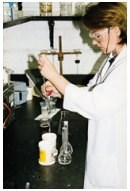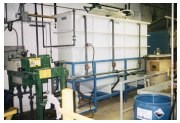Regenerative Electroless Nickel Plating Process
C.J. Saporito has minimized waste and reduced chemical costs with its new electroless nickel plating bath...
#pollution control
C. J. Saporito Plating Corporation (CJS) was founded in 1946 and has been providing quality plating services to industry for more than fifty years. Located in Cicero, Illinois, CJS offers a variety of metal finishing processes for electronic, aerospace, aircraft and commercial applications.
President and CEO Charles Saporito, Sr. and his management team headed up by Jim Mirabile, vice president of operations, and Jerry Rice, general manager, are constantly working to improve the quality of services offered in order to meet or exceed customers' expectations and industry standards.They are presently implementing a quality program designed to meet the requirements of ISO 9000 and expect to obtain ISO 9002 certification in mid-1998.
Featured Content
A computer system links all departments of CJS to provide greater efficiency in the daily operation of this growing finishing facility. Under the direction of Jeff Rice, industrial finishes of zinc, cadmium, hard chromium, diamond chromium, electroless nickel, electroless nickel Teflon, copper, macro/micro phosphating, nickel, zinc-nickel alloy, tin and as well as precious metal finishes of gold and silver are produced daily in rack, barrel or reel-to-reel plating applications.
CJS also operates two specialty divisions, Accurate Anodizing and Magnesium Anodizing. The analytical laboratory, directed by Yvonne Reno and staffed with three degreed chemists, provides both process control and the research and development for new technology.
Electroless nickel finishes are an integral part of the business CJS has specialized and built an expert reputation in for quality and reliability. CJS sends key employees to the Electroless Nickel School, run by Palm International, Lavergne, Tennessee, for a complete introduction to and training in modern electroless nickel plating technologies. The training complements and expands the theoretical and practical knowledge base in electroless nickel plating within the CJS operation.
CJS presently offers semi-bright and bright mid-phosphorus, semi-bright high-phosphorus and Teflon co-deposited electroless nickel finishes. Production is carried out in tanks ranging from 180 to 500 gallons, and these tanks are designed to process a wide variety of configurations and load sizes.
As with all electroless nickel platers, bath life and process stability are important for both cost and quality considerations. The inherent self-contaminating nature of the electroless nickel process due to orthophosphite build-up makes process selection critical to the efficiency of operations. This has led CJS to investigate a new electroless nickel technology that offers extended bath life and process stability by allowing for the precipitation and removal of the undesirable orthophosphite by-product.
CJS began its investigation in July 1994 in a 180-gallon tank. The regenerative electroless nickel process, manufactured by LeaRonal, Inc., Freeport, New York, was operated initially as a conventional production bath, processing a variety of base metals in both rack and barrel mode. The electroless nickel process provided a bright deposit with a phosphorus content of seven to 10 pct by weight, and a rate of deposition of 0.6 to 0.8 mil per hour. CJS obtained 10 to 12 metal turnovers (MTO) of bath life from the solution as compared to six to eight MTO from the previous electroless nickel solution. The bath performance exceeded current specifications.
CJS, having proved the fundamental capability of the process, investigated the regeneration system. The production bath was monitored for the level of orthophosphite in solution. When it reached 100 g/liter, batch treatment was carried out. Jeff Rice along with Steve Baisch, electroless nickel production manager, initially treated 40-gallon batches of production solution. As CJS became familiar with the treatment process, and convinced that it was viable, the decision was made to increase the scale of regeneration.
A 500-gallon installation of the regenerative electroless nickel chemistry was made, and again CJS initially checked its capability, subjecting the electroless nickel bath to its most critical work. The bath was deemed acceptable after the modification of its brightness level, and plans were developed to install large-scale regeneration equipment. Plasfab, Inc., Warwick, Rhode Island, was contracted to fabricate the necessary equipment for the regeneration treatment.
In July 1996, CJS installed the equipment and was ready to proceed. CJS now had 680 gallons of the regenerative electroless process in production. The 380 gallons (200 gallons from the 500-gallon tank and the entire 180-gallon bath) were transferred to the treatment equipment. The processing tanks were replenished with fresh make-up solution to maintain production. The combined 380 gallons of electroless nickel solution were analyzed at 93 g/liter orthophosphite. This figure was used to determine the quantity of precipitating agent needed.
Calculations are based on 70-85 pct orthophosphite removal. A four-hour mixing period followed to allow for a complete reaction. The treated electroless nickel solution was then recirculated through a filter press to remove the precipitate and produce a clear solution free of particulate. This was transferred to the final adjustment tank. The treated and filtered solution was pH adjusted, checked for nickel, hypophosphite, orthophosphite, and rate of deposition to insure that there was no inconsistency of the process when the solution was added back to the production operation. The adjusted solution was held in the final adjustment tank until needed to replace the next batch of production solution removed for orthophosphite treatment. This treatment scheme assures that no production time is lost due to the regeneration of solution.
The treatment of the regenerative electroless nickel solution yielded the following results:
The results show that the regeneration treatment was successful. The process removed 68.1 pct of orthophosphite with minimal retention of nickel and hypophosphite on the filter cake. Recovery of the nickel and hypophosphite can be achieved by circulating deionized water through the cake. This wash solution can either be used to replace evaporative losses or added to the treated solution prior to adjustment. If necessary, further washing of the cake can be carried out to lower the nickel content sufficiently to meet federal and/or local regulatory requirements for a non-hazardous substance.
The process of regeneration has become routine to CJS personnel, who are now using a semi-continuous treatment program based on ortho-phosphite levels in the production tanks. A weekly treatment of 370-390 gallons of regenerative electroless nickel solution is now scheduled. When a production solution reaches 100-120 g/liter a portion of the solution is withdrawn from the tank and replaced with treated solution having reduced orthophosphite levels.
The working bath is now at lowered orthophosphite levels, production is not interrupted and a new regeneration cycle is begun. The deposit characteristics have been uniform, and brightness level has been consistent.
The laboratory monitors the chemistry, performing a hypophosphite analysis and several nickel analyses per shift. The electroless nickel solution is maintained by nickel concentration above 90 pct chemical activity at all times. The July 1996 bath make-up of the 500-gallon tank has seen nine months of production and 70 MTO. CJS has now achieved its immediate goal of maintaining uniform deposit characteristics for extended periods from the regenerative electroless nickel process.
| Before Treatment | After Treatment | Pct Decrease | |
| Nickel Metal | 5.58 g/liter | 5.40 g/liter | 3.2 |
| Hypophosphite | 25.85 g/liter | 22.68 g/liter | 12.2 |
| Orthophosphite | 93.28 g/liter | 29.73 g/liter | 68.1 |
| pH | 4.90 | 4.93 | ---- |
The operation of the Electroless Nickel Department at CJS has become more efficient and profitable through the implementation of the regenerative electroless nickel process. The regenerative electroless nickel solution has allowed an increase in available production time, since the treatment cycle does not interrupt the production operation.
Waste minimization and chemical cost reductions have been achieved by eliminating eight electroless nickel solutions (4,000 gallons) for waste treatment and eight electroless nickel bath make-ups. By combining the latest available technology with ongoing training to improve expertise, the Electroless Nickel Department at CJ Saporito appears to be making all the right moves to meet and exceed customer demands in the 21st Century.
RELATED CONTENT
-
Plating Q&A: Can you color stainless steel?
Our expert, Art Kushner, says yes, you can color stainless steel, but it is not a process that is typically performed in a plating shop. Read more about his answer.
-
Zinc Electroplating
Choosing the best process for your operation.
-
Sizing Heating and Cooling Coils
Why is it important for you to know this?





















